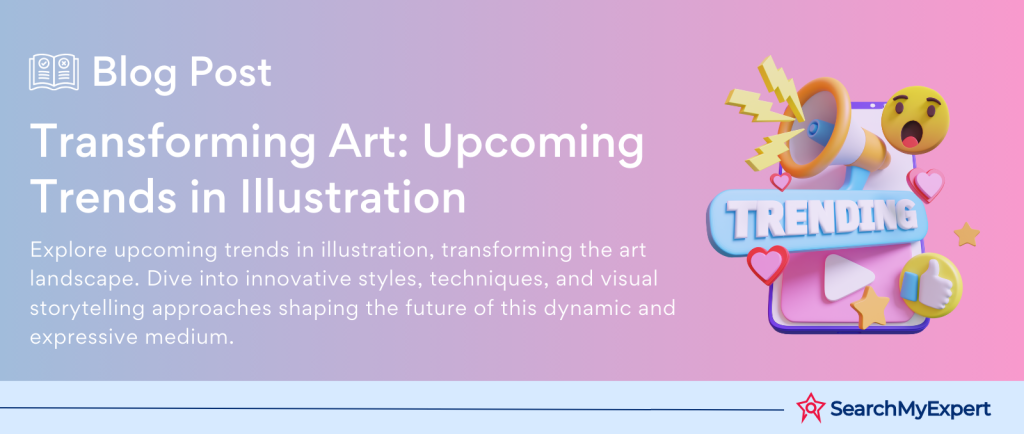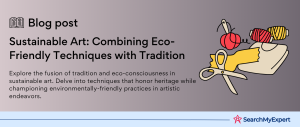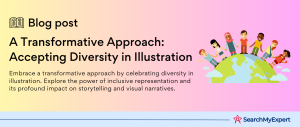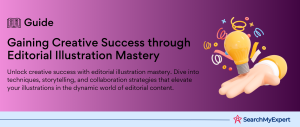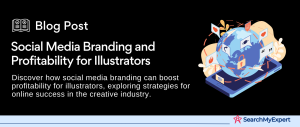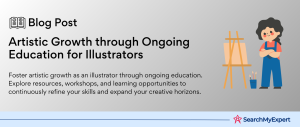Future Trends in Illustration
The Evolution of Illustration: A Journey Through Time
Illustration, a vibrant and evolving art form, has journeyed through centuries, continuously adapting and reinventing itself. From the intricate manuscripts of medieval times to the digital masterpieces of today, illustrations have always been more than just visual treats; they are powerful tools for storytelling, education, and expression.
The Increasing Significance in Diverse Fields
Today, illustration stretches its wings far beyond traditional canvases, influencing numerous sectors. In advertising, it captures the essence of brands; in education, it simplifies complex concepts; in digital media, it enhances user experience; and in literature, it brings stories to life. This versatility makes illustration an indispensable part of contemporary communication and design.
The Dynamic Nature of Art Trends
Art trends are as fluid as the rivers of creativity that feed them. What’s en vogue today might be a relic tomorrow. This ever-changing landscape challenges illustrators to continuously evolve, to not just keep up but to lead the charge into uncharted territories of creativity.
Exploring Future Possibilities
As we stand on the brink of new technological advancements and cultural shifts, the future of illustration is an unopened treasure chest of possibilities. Will AI integrate with human creativity? How will virtual reality redefine the canvas? These questions are not just hypothetical; they are the keys to unlocking the next chapter in the story of illustration.
Technological Advancements in Illustration
AI: Revolutionizing Creative Processes
AI-Assisted Creation: The New Frontier
Artificial Intelligence (AI) in illustration isn’t just about efficiency; it’s a paradigm shift. AI-assisted creation tools are enabling artists to explore realms previously unreachable. From generating complex patterns to assisting in color theory and composition, AI acts as a co-pilot in the creative journey, pushing boundaries and opening new avenues for expression.
Impact on Traditional Techniques
While traditional techniques retain their charm, AI integrates with them, enhancing rather than replacing. This synergy between human creativity and machine precision creates a unique artistic language, one that’s ever-evolving and endlessly fascinating.
VR/AR: A Leap into Immersive Art
Interactive 3D Illustrations: Beyond the Canvas
Virtual Reality (VR) and Augmented Reality (AR) have taken illustration from the 2D plane to a 3D realm. Artists now sculpt, paint, and draw in virtual environments, creating works that are not just seen but experienced. This leap into spatial art transforms the viewer into a participant, navigating and interacting with the artwork in real-time.
The Rise of Immersive Experiences
VR/AR technologies are not just tools; they’re gateways to new worlds. Illustrators can create immersive experiences, blurring the lines between reality and imagination. This isn’t just illustration; it’s a journey into the mind of the artist, a fully-realized vision that engulfs the senses.
Emerging Technologies: The Future Beckons
The Uncharted Territories
Other emerging technologies like holography, 3D printing, and motion capture are also playing their parts in shaping the future of illustration. They bring illustrations to life, adding dimensions of depth and motion, and transforming passive observation into an active exploration.
Blending Styles and Genres in Illustration
The Art of Mashing Up Styles
Hyperrealism Meets Abstraction: A Visual Symphony
In the realm of illustration, contrasting styles like hyperrealism and abstraction are being woven together to create striking, thought-provoking artworks. Hyperrealism brings meticulous detail and lifelike representation, while abstraction offers boundless freedom in form and color. Their fusion creates a visual symphony, a dance between precision and imagination, reality and interpretation.
Retro and Futuristic: Time Travel on Canvas
The interplay between retro and futuristic elements in illustration is like a time machine. It merges the nostalgic charm of past eras with the sleek, speculative visions of the future. This blend pays homage to history while boldly speculating about what’s to come, creating a timeless appeal in the artwork.
The Rise of Genre-Bending Illustrations
Fantasy and Surrealism: Escaping the Mundane
Fantasy and surrealism in illustration serve as gateways to worlds unbound by the laws of reality. These genres invite viewers to step into realms of magic, mystery, and metaphysical oddities, where the only limit is the artist’s imagination. They create spaces where the extraordinary is the norm, and the impossible is just another Tuesday.
Adding Social Commentary: Art with a Voice
Increasingly, illustrators are infusing their works with social commentary, making their art not just a feast for the eyes but also food for thought. By combining elements of fantasy and surrealism with poignant social themes, artists create powerful narratives that challenge perceptions, provoke discussions, and reflect societal issues.
Sustainable and Ethical Practices in Illustration
The Green Revolution in Art Materials
Eco-Conscious Materials: A Necessity, Not a Choice
The art world is increasingly embracing sustainability, with illustrators leading the charge. Eco-friendly materials, from recycled papers to non-toxic paints and digital tools that reduce waste, are becoming the norm. This shift is not just about reducing the environmental footprint; it’s a reimagining of the creative process, where respect for the planet is as integral as the art itself.
Sustainable Production: Beyond the Canvas
Sustainable production in illustration extends beyond just materials. It encompasses the entire lifecycle of the artwork, from creation to distribution. Digital platforms are playing a crucial role in this, offering ways to create and share art that minimize environmental impact.
Ethical Representation and Inclusivity in Illustration
More than Just Art: A Platform for Change
Illustration isn’t just a form of expression; it’s a powerful tool for social change. Ethical representation and inclusivity are at the forefront of modern illustration. It’s about ensuring that diverse voices and perspectives are not just included but celebrated in visual storytelling.
Diverse Perspectives: The Heart of Contemporary Art
The rise of diverse perspectives in illustration is a response to a globalized world. Illustrators from various backgrounds are bringing their unique experiences to the fore, creating a rich tapestry of stories that challenge stereotypes and promote understanding. This diversity is not just about representation; it’s about enriching the art form with a multitude of views and experiences.
Interactive and Personalized Experiences in Illustration
The Dawn of Responsive Art
Adaptable Illustrations: A Personal Touch
The future of illustration is not just in the hands of the artists; it’s increasingly in the hands of the audience. Interactive illustrations, which adapt and react to user input, are creating personalized experiences like never before. From digital canvases that change with the viewer’s mood to illustrations that evolve based on audience choices, this interactive art form offers a unique, personal connection between the artwork and its beholder.
Technology as the Enabler
Advanced technologies like AI, motion sensors, and touch-responsive interfaces are the catalysts for these interactive experiences. They allow illustrations to become living entities, responding to the environment and the audience in real-time, providing a dynamic and ever-evolving artistic experience.
User-Generated Content: Democratizing Illustration
The Power of Social Media Platforms
Social media platforms have revolutionized how we interact with art, giving rise to user-generated content. These platforms empower individuals to contribute to the creative process, blurring the lines between artist and audience. Users can now modify, remix, and interact with illustrations, creating a collaborative art form that is constantly evolving.
Crowdsourced Creativity: A New Artistic Movement
This trend of user-generated content is more than just a feature of social media; it’s a new artistic movement. It’s about collective creativity, where the audience becomes co-creators, adding their unique perspectives and ideas to the artwork. This collaborative approach enriches the art, making it more diverse, inclusive, and reflective of a broader spectrum of experiences and viewpoints.
Bridging the Physical and Digital Divide in Illustration
The Fusion of Real and Virtual Worlds
Augmented Reality Installations: Art Redefined
The lines between physical and digital art forms are becoming increasingly blurred, especially with the advent of augmented reality (AR) installations. These installations offer a new dimension to art, overlaying digital elements onto the physical world, creating a hybrid reality where art leaps off the canvas and into the space around us. This fusion redefines the viewer’s experience, transforming passive observation into an interactive, immersive journey.
Hybrid Art Forms: The Best of Both Worlds
Hybrid art forms are at the forefront of this fusion. They combine traditional artistic techniques with digital innovation, creating artworks that transcend boundaries. This blend allows artists to explore new textures, dimensions, and interactions, providing a richer, more multi-faceted experience.
Phygital Illustrations: Seamless Integration
The Concept of “Phygital”
“Phygital” – a blend of physical and digital – is the new buzzword in the world of illustration. It’s about seamlessly merging digital elements with tangible objects, creating illustrations that exist both in the real world and the digital realm. This concept is not just about visual appeal; it’s about creating a holistic experience that engages all the senses.
The Future of Interactive Art
Phygital illustrations represent the future of interactive art. They allow for a level of engagement and personalization previously unattainable. Whether it’s a painting that changes with the viewer’s movements or a sculpture that interacts with a mobile app, phygital art forms create a bridge between the artist’s vision and the audience’s experience, making each interaction unique and personal.
The Future of Storytelling and Communication in Illustration
Illustration: A Canvas for Storytelling
Evolving Narratives
Illustration, historically a visual supplement to text, has evolved into a standalone medium of storytelling. Its capacity to convey complex narratives, emotions, and experiences makes it a powerful tool for communication. As our society becomes more visually oriented, illustration steps up as a universal language, transcending linguistic and cultural barriers.
Emotional Resonance
The emotional impact of illustration is profound. A single image can evoke a spectrum of emotions, from joy to sorrow, anger to empathy. This emotional connection makes illustration an effective tool for engaging audiences, making them not just viewers but participants in the narrative.
Raising Awareness: Illustration as a Social Catalyst
Illustrations on Social Issues
Illustrations are increasingly being used to raise awareness and spark conversations on critical social issues. They have the unique ability to present complex topics, like climate change, social justice, and mental health, in an accessible and relatable manner. This approach not only informs but also inspires action, making illustration a catalyst for social change.
Empathy through Art
By portraying the experiences and struggles of diverse groups, illustrations promote empathy and understanding. They break down stereotypes and challenge preconceived notions, fostering a more inclusive and empathetic society.
Predicting the Future of Illustration
Conveying Complex Ideas
As we look to the future, illustrations will play a crucial role in conveying complex ideas and messages. With advancements in technology and the rise of digital media, illustrators will have new tools at their disposal to create even more engaging and impactful works.
Embracing Digital Platforms
Digital platforms will expand the reach of illustrators, allowing them to connect with global audiences. Social media, virtual galleries, and interactive installations will offer new avenues for sharing and experiencing art.
Interactive and Immersive Experiences
The future of illustration lies in interactivity and immersion. We’ll see more illustrations that not only tell a story but also invite the audience to become a part of it. Augmented reality, virtual reality, and interactive installations will transform illustrations into multi-sensory experiences.
Conclusion
The future of illustration is bright, painted with endless possibilities. As a tool for storytelling and communication, it holds immense potential to influence, inspire, and ignite change. Illustrators of the future will not just be artists but storytellers, educators, and activists, wielding their pens and brushes to shape the narratives of tomorrow.
Transform your projects with the talent of Illustrators Companies.
Table of Contents
Toggle
